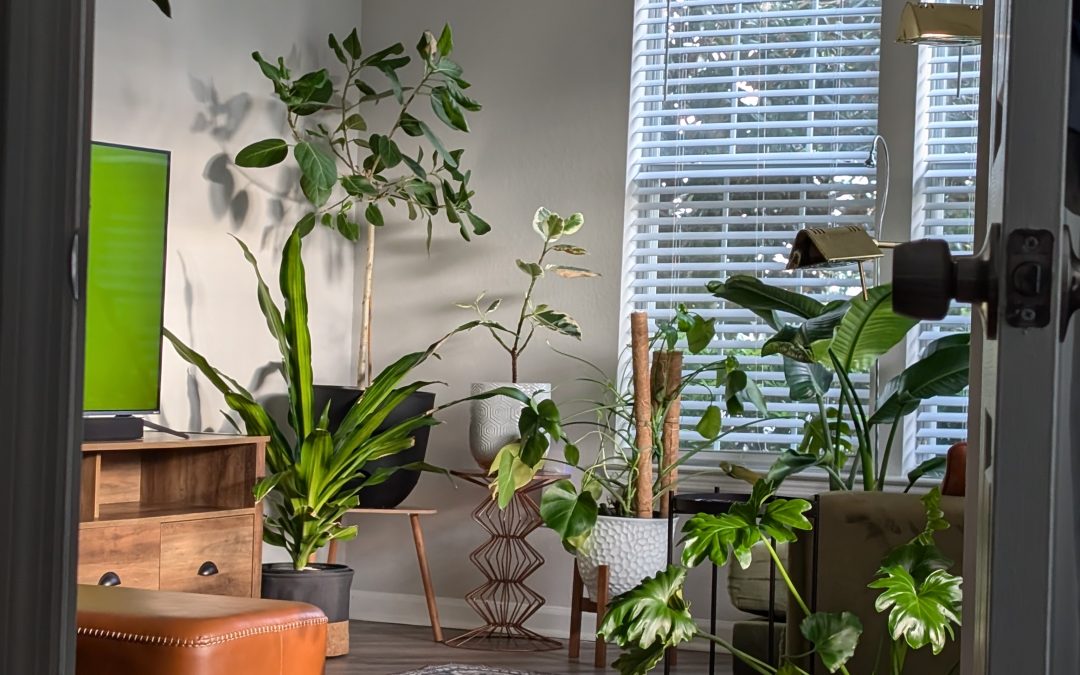
by Dr. Leynar Leyton | Dec 18, 2024
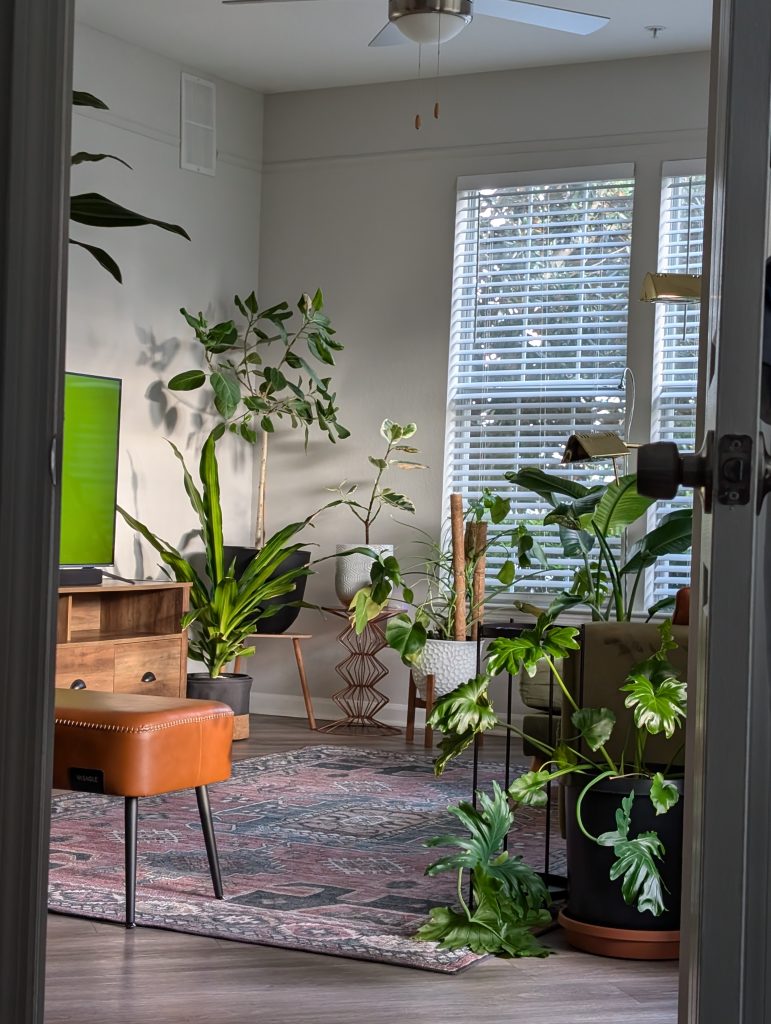
House plants. Photo by Dr. Leynar Leyton, UF/IFAS Ornamental Plant Breeder and Assistant Professor in Environmental Horticulture.
As we approach winter, and temperatures start to drop, you might have brought some plants inside your home. Or maybe you were at the garden center and fell in love with a unique lush plant, but as you get home, you are now wondering how you take care of your newest indoor plant… I believe I might can help! I will try to cover the basics of indoor plant care in this short article, so your plants thrive inside your home. These recommendations work not only for new plants that you bring home, but also, for your current house plants.
–Let’s start with light
One of the most important factors that affect house plants is light. Plants make food out of light through photosynthesis. Without enough light, they cannot produce enough food to survive. Plants can be divided into low, medium, high, and very high light requirements. These four categories are very helpful when you try to decide where to place your plant at home. Now the question is: How do you know the light requirements of your plant? Your first bet will be the plant tag or label. Plant labels usually contain the name of the plant and its light and water requirements (we’ll talk about water requirements in a bit). If they only have a name, a quick google search will help you with the light requirements of your plant.
Generally speaking, and without taking into consideration the layout of your home – think trees, windows treatments, size of your windows, other structures
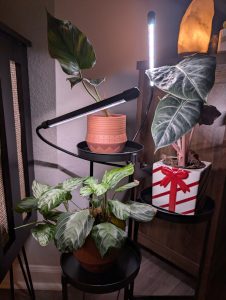
House Plants under artificial / grow lights. Photo by Dr. Leynar Leyton, UF/IFAS Ornamental Plant Breeder and Assistant Professor in Environmental Horticulture.
nearby, and time of the year – eastern exposed windows will provide the best light conditions for most indoor plants, with direct sunlight from sunrise until approximately midday. Windows with a southern exposure provide a long range of light intensities during the year. For example, during this time of the year (as we approach winter) and during most of the daylight hours in winter, the sun will shine throughout the room. In summer, the sun would be farther north, making the sunlight enter the room only after midday. Western exposed windows have very similar light conditions to southern exposed windows. The windows with the least amount of light year-round would be a northern exposed window, as the United States is in the northern hemisphere and most of the sunlight comes from the south.
Plants will tell you if they don’t have enough light. One of the most noticeable signs is that your plant will not grow, and the internodes (the distance on the stem between leaves) on new growth would be much longer than the internodes on older parts of the plant. Other signs could be that the new fully expanded leaves are smaller – and with a much lighter green color – than the older leaves, as well as dead old leaves. If your plant is not receiving enough light, there is still some things you can do to help. You can move the plant closer to the window or move the plant to a brighter room, either with a better exposure or a room that has artificial lights turned on during the day. Light intensity is important but also the number of hours your plant is exposed to light. This is very important if you decided to invest in artificial lights for your plants. You do not need a very intense light, if you keep it on for a longer period of time – say 16 hours. Whatever you do, keep in mind that too much light can be damaging to plants. You need an adequate amount of light for your plants, not an excessive amount of light. Also, be mindful when moving a plant from low light conditions into high light conditions, for example direct sunlight, as leaves can be burned or look bleached.
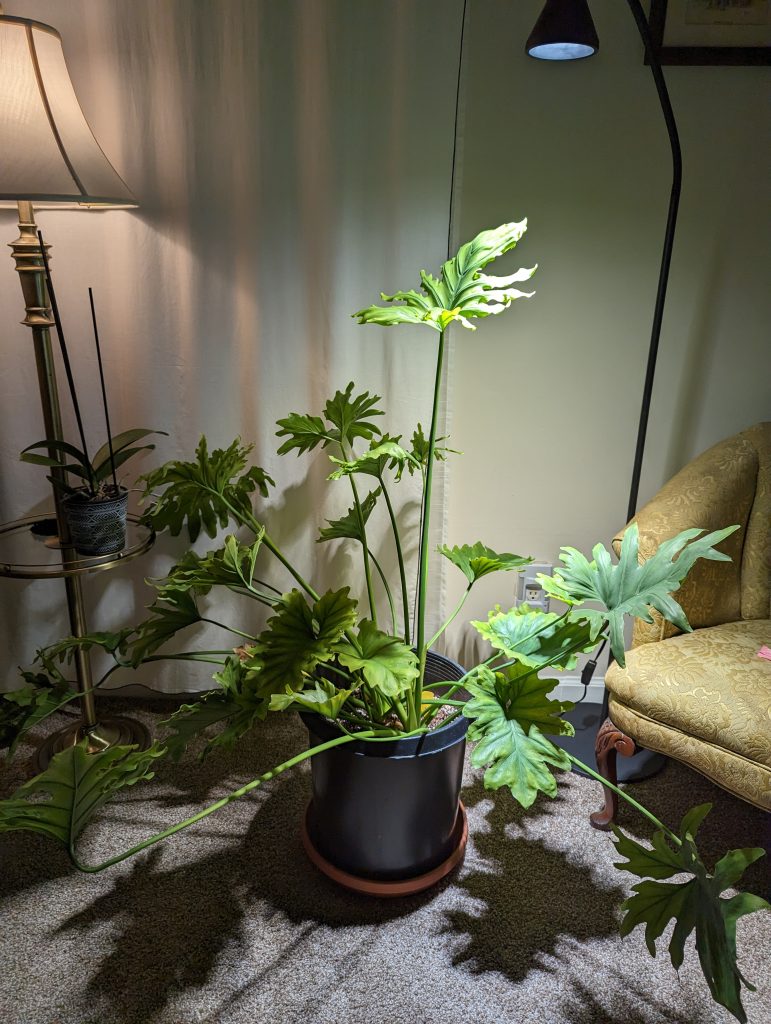
Thaumatophyllum bipinnatifidum showing sign of low light exposure. Photo by Dr. Leynar Leyton, UF/IFAS Ornamental Plant Breeder and Assistant Professor in Environmental Horticulture.
-What about temperature?
The second major factor that affect your house plants is temperature. We feel comfortable in temperatures ranging from 72 to 82 °F. Indoor plants are originally from tropical and sub-tropical parts of the world and can grow well in temperatures ranging from 58 to 86 °F. Based on those temperature ranges, house plants should do pretty good in your home. However, we need to understand the relationship between temperature and light, and how plants produce and use their “food”. When we talked about light, we mentioned that plants made food out of light through photosynthesis. Well, that is only half of the story. Plants use that food in a process called respiration, which produces energy that is used in developing new leaves, growth, and for maintenance of leaves and roots. High temperatures increase respiration, forcing plants to use more food to produce energy, reducing their efficiency. Imagine a plant under not optimal light conditions, struggling to produce some food (mainly carbohydrates, sugars, and starch) during the day. If the plant is in a warmer room of your house, all those few carbohydrates produced will be used quickly. As a result, your plant will not grow, because plants will use those sugars to maintain the current leaves, rather than use that energy in producing new leaves or roots. Another aspect to consider is that plants – like people- might like a specific temperature in the 58 – 86 °F range. Some plants like a warmer environment, and others can withstand “colder” environments. A good rule of thumb is to never allow temperatures drop below 50 °F and keep your thermostat in the 70 – 80 °F during the day, and 65 – 70 °F at night. Be mindful of “away” schedules on your thermostat or plants that are too close to a vent or heater.
-Water
The last factor I want to talk about is water. This is probably the most common and controversial topic in plant care. How often should we water our plants?
Should we bottom water or top water? Is tap water, ok? All these questions might be overwhelming, but I’ll try to go through the basic principles behind those questions so you can make your own watering decisions. Firsts of all, it is important to recognize that each plant will have a specific water requirement. Some plants require more water than others; this information should be in the plant tag when you bought it. Other factors that will affect the amount of water a plant needs are:
-Size of the plant. Bigger plants will require more water because they are bigger.
– Pot or container. Smaller pots will hold less water (they dry out faster), meaning you’ll have to water them more often.
– Soil texture or type. Some types of soils will retain more water than others.
-Light intensity. Plants under high light intensity will require more water, as water is need it for photosynthesis.

Dracena dying due to root rot. Photo by Dr. Leynar Leyton, UF/IFAS Ornamental Plant Breeder and Assistant Professor in Environmental Horticulture.
Be mindful and do not over water, or let water stand in saucers for days. Too much water, or plants in standing water for long periods of time can produce root rot, a fungal infection in the roots that plants usually cannot recover from. Another problem caused by standing water from irrigation is the accumulation of salts washed off from the soil. Make sure you discard any water that had drained into the saucer and has been in the saucer for more than a day after watering your plants. A good way to learn when to water your plants is to know and understand them: If you check your plants constantly, you’ll learn how long it takes them to use the water in the soil. You can check that by checking the “weight” of your plants. Grab the pot right after you water it and feel how heavy it is. As the days pass, when you grab the pot, you’ll notice that it is lighter. If it is considerable lighter, it’s time to water. With that information, you can make your own watering schedule, or simply check your plants every other day and water when need it. Water quality is also important, especially for green leafy plants. Now, what about tap water? The reason some people don’t recommend using tap water to water your plants is because it contains fluoride and chlorine, and leafy green plants are sensitive to these chemicals. A typical sign of water quality problems is burned tips or edges of leaves. An easy way to deal with this problem is to let your watering water sit for a few days before use it, as fluorine and chlorine will be released from the water to the air. You could also just use filtered or distilled water.
I hope this article helps you a little in the care of your indoor plants. Plants are resilient organisms and if you do make a small mistake, they will probably be ok. Remember that gardening is an art and a science!
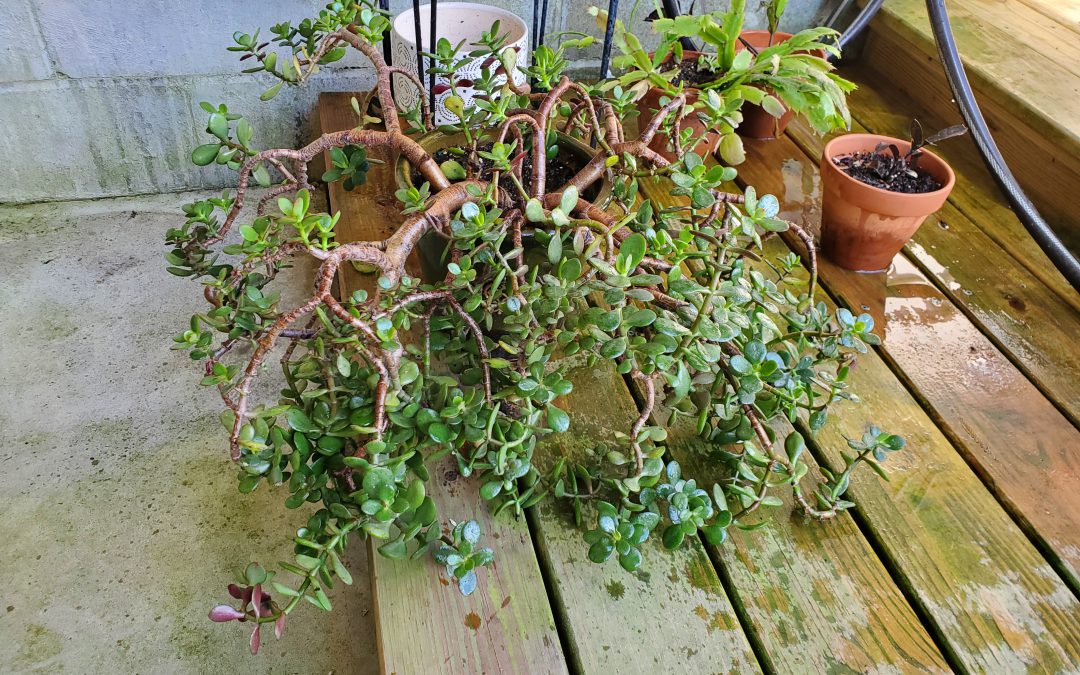
by Daniel J. Leonard | Jul 14, 2022
It seems like every time I pick up a home and garden type magazine, the cover photo is dotted with flowering orchids and indoor foliage plants that are inevitably in pristine condition. However, years of experience troubleshooting issues with both my own interior plants and those for clients tell a different story. All too often, indoor potted plants languish for years, barely alive, until they finally succumb. I’ve taken several to the plant graveyard just past the edge of the back yard because of this exact scenario. In recent times though, I’ve figured out a way to mostly avoid pitiful looking indoor plants – take them outside in the warm months!
To appreciate the perks of getting your indoor plants outdoors, it’s helpful to first think about why most interior situations aren’t very conducive to plant growth. There are three primary reasons houseplants fail: not enough light, improper watering, and low humidity. Most plant species grown for interiorscapes hail from the tropics where they grow in the understory of large trees, receive bright, filtered sunlight, and experience abundant moisture and humidity. These conditions are VERY hard to mimic in the typical American house unless you huddle all your plants near windows, take steps to increase humidity (which doesn’t play super well with furniture and other household items), and really tune in your watering. Taking indoor plants outside to play in the Panhandle summers just really makes the whole situation much easier!

A Jade Plant that had languished indoors during the winter beginning to perk up outside! Photo courtesy of Daniel Leonard.
Now that you’ve made the decision to move your indoor plants out, figuring out where to site them is the next step. I’ve found that, with few exceptions, houseplants prefer to be in a bright area but away from direct sunlight – under mature trees, on a covered porch, anywhere that doesn’t get direct sunlight will do! It is also a great idea to place plants near a watering source. If a hose doesn’t easily reach the spot or it’s inconvenient to tote a watering can to them, your plants won’t get watered regularly and will suffer. You’ll be surprised how much water plants use when they’re in conditions conducive to growth so be sure to check pots every couple of days to prevent droughty conditions! Once in these new and improved growing conditions, your houseplants will also respond very well to a little extra fertilizer. A good general prescription is a topdressing of a slow-release fertilizer using the recommended label rate as soon as you bring them outside and following that up once each month with a supplemental liquid fertilizer.
Keeping houseplants happy in the Florida summer is easy and begins with getting them outside. Find a spot with bright, indirect light, keep them watered well, add a little fertilizer, and watch them grow like they never have before! For more information on growing houseplants or any other horticultural or agricultural topic, contact your local UF/IFAS County Extension office. Happy gardening!

by Matt Lollar | Nov 22, 2021
Houseplants can soften up the interior of your home and help clean the air. They can also supplement your holiday decorations and help create stunning focal points. To help determine what plants do best under certain conditions and to give pointers on plant care, this month’s Gardening in the Panhandle LIVE! was all about houseplants.
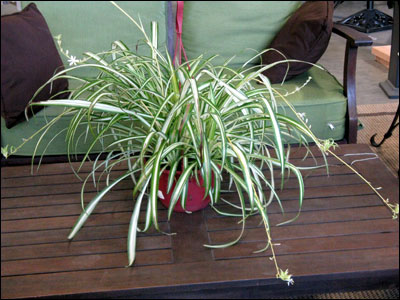
A spider plant on a coffee table. Photo Credit: University of Florida/IFAS
Environmental Conditions for Houseplants
Unless you live in a glass house, you’ll probably want to choose houseplants that do well in low light conditions. A guide for what light level different houseplants prefer can be found on the Gardening Solutions Light for Houseplants page. This page also provides useful tips on supplemental lighting.
Some houseplants are better at cleaning the air than others. A list of houseplants that do a good job improving indoor air quality can be found on the Gardening Solutions Houseplants That Clean the Air page.
The best way to determine if your houseplants need water is your own green thumb or whatever finger you choose to stick in the potting mix, but for some interesting information on outdoor soil moisture meters check out this informative publication on soil moisture sensors.
Houseplants need a good quality, well-drained potting mix to thrive. Tips on selecting a potting mix can be found on the Gardening Solutions Container Media page.
Houseplant Pests
One of the best ways to rid houseplants of insect pests is to set the plants outside for a few days and let the pests move on. For some information on pest control products in and around the home check out the publication Natural Products for Managing Landscape and Garden Pests in Florida.
Fungus gnats are mainly a nuisance, but some species can feed on living plant tissue. Darkwinged fungus gnats are known to feed on ferns, orchids, and geraniums.
Houseplant Propagation
One way to increase your houseplant population and save a few dollars is to propagate your own plants. The University of Florida/IFAS created the Plant Propagation Glossary to help with any propagation questions you may have.
Air layering is a propagation technique that not only allows the prospective plant to thrive from the nutrients of the mother plant, but it also saves space.

A moth orchid (Phalaenopsis spp.) outdoors. Photo Credit: University of Florida/IFAS
Specific Species Info
Orchids in the genus Phalaenopsis are easier to care for than other genera of orchids. The American Orchid Society provides some great tips on caring for orchids indoors. Some people choose to water their orchids with ice cubes. The Ohio State University has a publication that provides some more insight on watering Phalaenopsis orchids with ice cubes.
A lot of cacti do well indoors. A popular cactus during the holiday season is Christmas cactus. Christmas cactus have interesting foliage, but their blooms are what people want to see. Some tips on getting your Christmas cactus to bloom on time and general care information can be found in this Christmas Cactus Preparation fact sheet.
Have you ever wanted to grow fruit trees indoors or do you want some tips on bringing containerized fruit trees indoors for the winter? The Growing Fruit Crops in Containers publication provides some good tips on growing fruit trees indoors.
Unless you have a house with a lot of windows or a sunroom, plumeria don’t make the best houseplants. They need at least six hours of sunlight per day and need to be at least three years old to bloom. If you are interested in propagating plumeria, then check out this publication on propagating plumeria from cuttings.
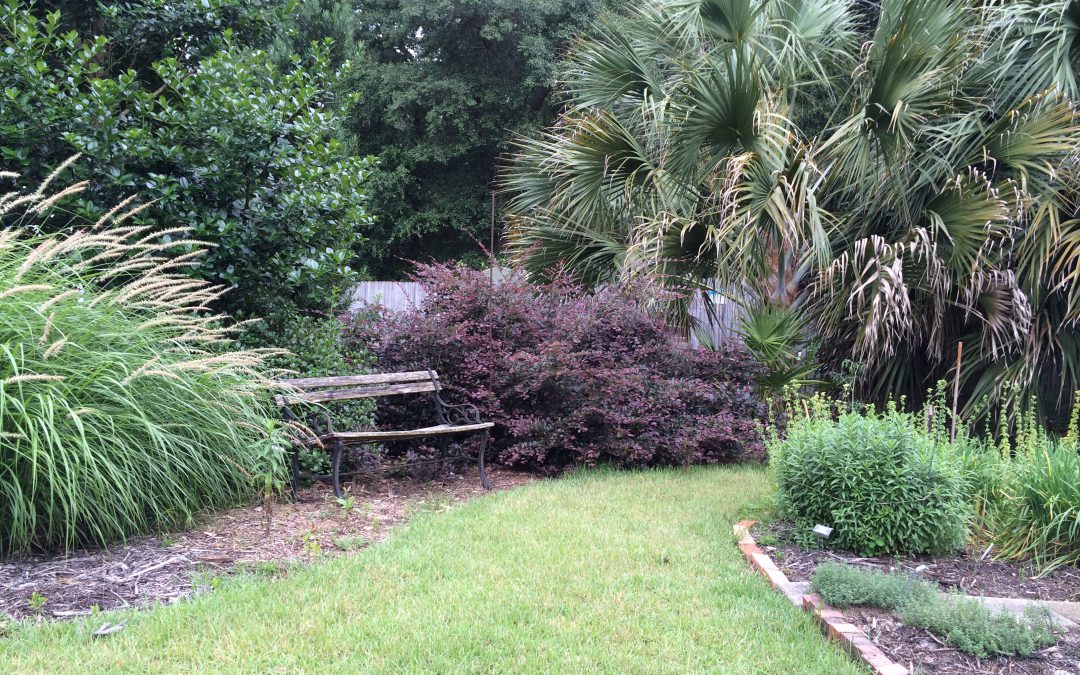
by Roy Carter | Jun 23, 2014
Summertime is vacation time for people, not plants! While getting ready for that long awaited trip, it’s easy to forget about your lawn, landscape, vegetable garden and house plants. A little time spent preparing your leafy friends for your absence could save you needless worry and hours of extra work when you get back.
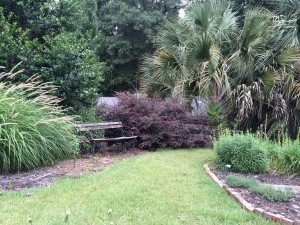
Prepare your landscape for your absence.
Photo by Mary Derrick, UF IFAS
A vacation may be relaxing and rejuvenating for you and your family, but it can be hazardous, even deadly, for your plants. Unless you make adequate preparations before leaving, you could return to vegetable disaster.
One of the first things you might do before leaving home is ask a neighbor to check your plants periodically while you’re gone. All plants need some care. During an extended vacation container grown plants require special attention and different species have different needs. Be sure you give your friend specific instructions for the care of each type.
If you can’t find someone to personally look after your plants while you’re away, there’s plenty you can do prior to departure to make sure you don’t come home to a limp landscape and sickly house plants. Outdoor container plants should be placed in a shady area to conserve moisture. Under a tree or on the north side of a building are good locations. A thick layer of mulch will help conserve moisture for landscape plantings. Mow your lawn just before leaving, cutting the grass a little closer than usual. An unkept lawn can encourage disease, and it’s a tell-tale sign that no one’s home.
Give lawn and landscape plants a heavy watering – especially recently planted beds, which will need extra moisture. Also, thoroughly spray or dust your plants to protect them from insects and diseases while you’re away. If you have flowering annuals, cut the blossoms before departing. If you don’t, they’ll soon stop blooming. Harvest all ripe or nearly ripe fruits and vegetables. Like flowers, they will continue to produce only if they’re picked frequently. Otherwise, they’ll go to seed.
Do a thorough job of weeding. If weeds are allowed to go to seed while you’re away, you can expect to encounter much more difficult problems later in the season – even next year – when the seeds sprout. Weeding eliminates a major source of competition for your landscape plants’ food and water which may be in short supply during your absence.
Plants kept indoors require special consideration. Before leaving home, place your house plants in a room which receives indirect sunlight. Direct exposure to the sun will dry the soil too quickly. Of course, you don’t want to put your plants in a room that’s too dark, either. Too little light will almost always result in leaf drop. And, just before you depart, be sure to water your house plants thoroughly. This is especially vital, because – unlike lawn grass and landscape ornamentals – house plants cannot benefit from any rain that may fall while you’re gone.
You’ll enjoy your vacation more by making sure your plants are well prepared for your absence.

by Mary Salinas | May 13, 2014
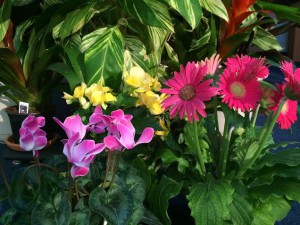
Flowering Houseplants. UF IFAS photo by Mary Derrick.
Plants add color, interesting textures and, of course, beauty to our indoor living environments. The air is freshened with the oxygen they provide.
Keep them healthy by watering correctly. Plants have differing water requirements so take a moment to look up some good research-based information on your particular plants and find out what kind of watering regime is best for them. For most houseplants, it’s time to water when the top inch or so of soil is dry to the touch. Some do best when they dry considerably before watering, like succulents, while others, like cineraria, like to stay evenly moist. It may help to group your plants by their water requirements so you can better remember and manage their watering needs.
When it is time to water, make sure to water thoroughly so that excess water drains from the pot. There are several really good reasons to follow that practice. First, a thorough watering allows all the soil and roots to be moistened and you avoid having dry spots in the soil. Also, when the excess water drains, it takes with it the excess salts from fertilizers. When excess salts build up over time, the roots can be damaged and the plant can eventually die. One of the first plant symptoms is brown, dead tips of the leaves. A definitive sign of excess salt is a white mineral build up around the inside edges of the pot or on the surface of the soil. If you already have a salt build-up, you can water heavily a few times to help leach the salts or re-pot your plant with some fresh potting soil.
One last tip – once you water your plants, don’t let the pots and the roots sit in water. Dump out any standing water.
For more information, please see:
Solutions for Your Life: Houseplants
Gardening Solutions: Salt Build-up in Houseplants
Virginia Extension: Indoor Plant Culture














